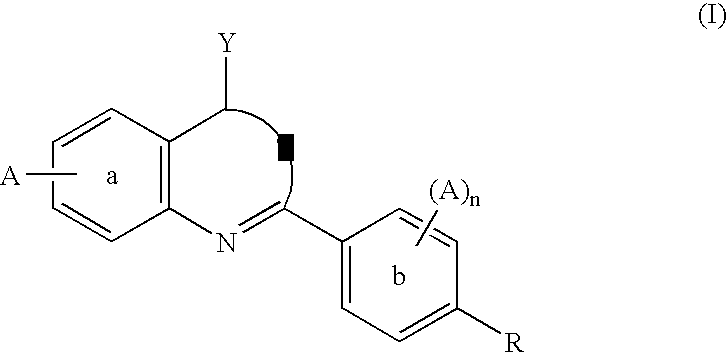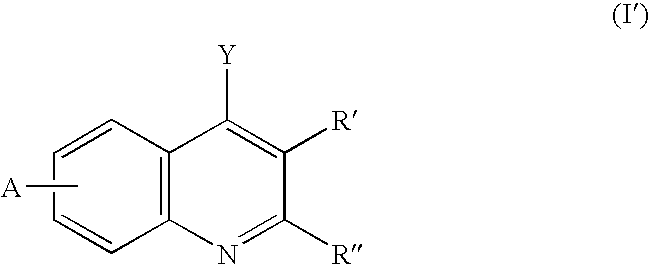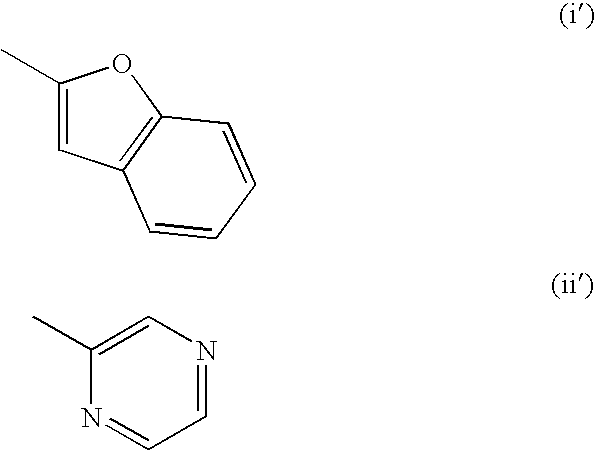Dihydroorotate dehydrogenase inhibitors for the treatment of viral-mediated diseases
a technology of dihydroorotate and dehydrogenase inhibitors, which is applied in the direction of biocide, plant growth regulators, animal husbandry, etc., can solve the problems of high dosage of ribavirin, no effective treatment of chronic diseases, and accompanying red blood cell toxicity, and achieves potent activity
- Summary
- Abstract
- Description
- Claims
- Application Information
AI Technical Summary
Benefits of technology
Problems solved by technology
Method used
Image
Examples
example 1
Test compounds were weighed and freshly dissolved in dimethyl sulfoxide (DMSO). Stock solutions of each chemical in DMSO were kept at 4° C. or for longer storage at minus 80° C. The stock solutions were diluted in regular medium such that the concentrations of each chemical ranged down from 100 μM as they were serially diluted two times to nM concentrations.
Human liver (HuH7) cells, human primary fibroblats (MRC5) and transformed monkey cells (Vero) cultured in 96 well microtitre plates were each grown to near confluency in regular medium The media was removed and each well of cells was re-incubated with 0.1 ml, of regular medium containing 1 to 2% of fetal calf serum, different concentrations of each of the chemical compounds dissolved in regular medium and an amount of each of the viruses listed in Tables 1 and 2. The controls consisted of cell controls (cells treated with chemical compounds but not with virus) as well as viral controls (cells treated only with virus but not with ...
example 2
Vero cells and HuH7 cells were grown to about 99% confluency in 96 microwells with minimum essential medium (MEM) containing 10% fetal calf serum. Growth medium was removed from the microwells and incubated with one of the following:(1) 100 μl of interferon α8 containing either 6, 3, 0.6, 0.3, 0.06, or 0.03 IU of interferon (Reference to Gb 23-902-531, NIH standard, distributed by the Natl. Inst. Allergy and Infectious Diseases, NIH, USA) per ml of MEM containing 2.5 mg / ml human serum albumin.(2) 100 μl of interferon α2 containing either 6, 3, 0.6, 0.3, 0.06 or 0.03 IU of interferon (Reference to MRC 69 / 19 as well as Gb-23-902-531 standards) per ml of MEM containing 2.5 mg / ml hum an serum albumin.(3) 100 μl of interferon β containing 60, 30, 6, 3 or 0.6 IU of interferon (Reference to Gb23-902-53 1 standard) per ml of MEM containing 2.5 mg / ml human serum albumin.
The experiment was done in quadruplicates or duplicates. After the addition of interferon to the Vero cells in the microwel...
example 3
Peparation of Novel Compunds of Formula IIa
A mixture of the trifluoromethoxy-substituted isatin of formula (IX) defined above (0.3 mmol) and potassium hydroxide (1.8 mmol in 1 ml of water) was heated at 125° C. in ethanol (2 mL) for 2 hours. A ketone of formula (X) as defined above in which R22, R33, R44 and R55 are all hydrogen (0.6 mmol in 1 mL ethanol) was added and the mixture was refluxed further for 12 hours.
The mixture was cooled and concentrated under reduced pressure. The residue was taken up in water (25 mL) and extracted with diethyl ether (2×20 mL). The aqueous layer was acidified with glacial acetic acid until precipitation occurred. The resulting precipitate of 2-(4-biphenylyl)-6-trifluoromethoxy-quinoline-4-carboxylic acid (compound I2K5) was filtered, washed thoroughly and dried in high vacuum for 2 days.
Characterising data for the compound are as follows: NMR: (Acetone-d6, 400 MHz)) δ:7.42-7.54 (m, 3H), 7.76-7.79 (m, 3H), 7.88(d, J=8.44 Hz, 2H), 8.30 (d, J=9.16 Hz, ...
PUM
 Login to View More
Login to View More Abstract
Description
Claims
Application Information
 Login to View More
Login to View More - R&D
- Intellectual Property
- Life Sciences
- Materials
- Tech Scout
- Unparalleled Data Quality
- Higher Quality Content
- 60% Fewer Hallucinations
Browse by: Latest US Patents, China's latest patents, Technical Efficacy Thesaurus, Application Domain, Technology Topic, Popular Technical Reports.
© 2025 PatSnap. All rights reserved.Legal|Privacy policy|Modern Slavery Act Transparency Statement|Sitemap|About US| Contact US: help@patsnap.com



